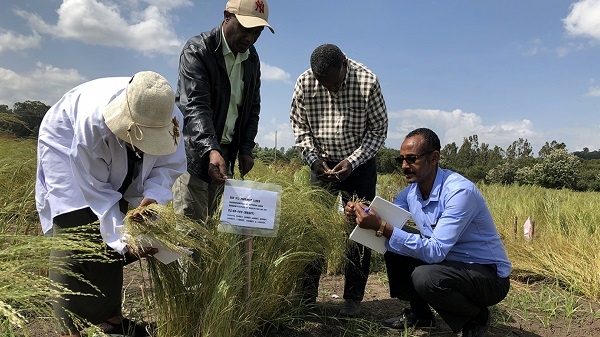
Researchers at the Debre Zeit Agricultural Research Center are turning to nuclear technology for help to avoid the damaging consequences of climate change on teff production
By Miklos Gaspar (IAEA)
BISHOFTU, Ethiopia – Teff may be an emerging superfood in the global arena – but this Ethiopian cereal crop may not be ‘super’ enough to withstand the consequences of climate change: less rain and strong winds.
Teff, a grass-like plant with tiny seeds, is the staple food for over 60 million people in Ethiopia and is the basis of traditional Ethiopian cuisine. As a naturally gluten-free grain, it is also gaining popularity among health-conscious customers in developed countries.
While it is very adaptive to the different climatic and soil conditions of the country, it has a low yield of only around 1.5 tons per hectare, less than half the average yield of maize in Ethiopia. And even this meager yield is under threat from decreasing rainfall and unprecitable weather, researchers say.
Plant breeders at the Debre Zeit Agricultural Research Center, an hour southeast of Addis Ababa, are turning to nuclear technology for help. Over the past three years, with the support of the IAEA, in cooperation with the Food and Agriculture Organization of the United Nations (FAO), they have been experimenting with using different doses of gamma irradiation to create new plant varieties with favorable traits: shorter stems that make it less susceptible to lodging, shorter maturity period, which would require less water, and higher yield and protein content.
“Unlike for most other crops, which are grown in several countries, for teff there is no global breeding community or international experience on what may be successful means to achieve desired varieties,” said Solomon Chanyalew, Director of the Center and a teff researcher himself.
In Ethiopia, teff is of utmost importance: it is grown on over 3 million hectares of land by 6 million smallholder farmers.
Solomon* and his team have treated seeds of different cultivars with radiation doses of between 200 gray and 2000 gray– or between 10 and 100 million times more than a typical chest X-ray – to create the necessary genetic diversity to select for improved lines. The radiation induces changes in the DNA of the seeds, and some of the resulting lines will have favorable characteristics. Researchers are looking for the “sweet spot” of radiation level – just strong enough to change the characteristics of the plants but without killing them. This alteration is akin to what happens in natural mutation or traditional breeding selection and line crossing – but in a process that is speeded up. Smaller seeds require much higher doses of radiation to create changes in their DNA.
Continue reading this story at IAEA
* Ethiopians use patronymic names rather than family names. That is, a person in Ethiopia is addressed by his/her given name as there is no such thing as ‘family name’ or ‘inherited name.’
